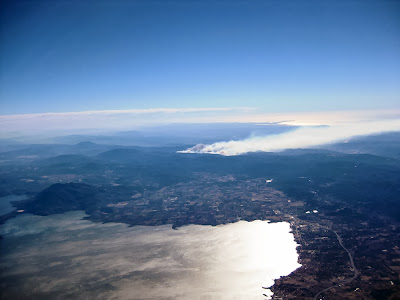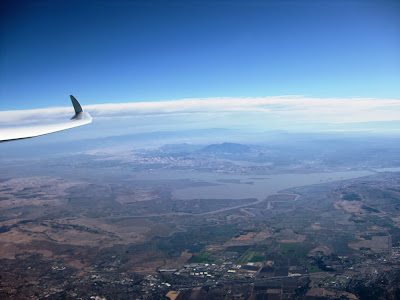After those two incredible flights, I was eager to put what I had learned into practice. So I started watching the forecast winds aloft charts, and on Thanksgiving eve it appeared to me that the winds might be favorable for a wave flight on Monday, December 2. By Friday night, the RASP BLIPMAPs (a regional soaring forecast) were supporting my theory so I reserved Williams Soaring Center's ASW-24 for the day.
I set a very modest goal (by Kempton standards) to get in the wave near Goat Mountain and run as far north as Alder Springs' latitude and yo-yo between the two points and see how many "laps" I could do. Well, the answer ended up being just one!
I took off at 11:30 and towed west towards the mountains fully expecting to encounter wave on the way out. But the only lift we encountered during the tow was right near the airport just after taking off! The tow pilot took me to an area between Goat Mountain and Snow Mountain. I got off tow and started searching for the wave. After searching for almost ten minutes and thinking I might have to return, I finally connected with weak lift near Goat Mountain at about 8,500'. After mapping the area I started my initial climb.
The day started off void of any tell-tale lenticular clouds to help find the lift. This photo is looking to the north as I neared the top of my initial climb. The eastern half of Snow Mountain is on the left and Saint John's Mountain is in the center of the photo. You can also see the cloud deck of the approaching storm in the distance. (Wind is L to R)
The ClearNav display shows my initial search efforts and the small area I was working (the green tracks are in lift and the black tracks are in sink). The straight green track above my current position was while I was still on tow and I released where the track makes a 90 degree turn to the right. The black line that extends from the glider to the lower right of the display depicts the path back to Williams.
I climbed to 14,800' and then departed to the north. I went to Snow Mountain and attempted to find lift in an area relative to where I had found the lift at Goat Mountain, to no avail. Then I noticed that a well defined lenticular cloud had formed to the northeast of Saint John's Mountain and headed for it.
I entered the lift at about 11,000' and by the time I had climbed back up to about 14,000' I started north to my goal of Alder Springs.
This is looking back to the the area of my initial climb. You can see: 1-Goat Mountain, 2-Clear Lake, 3-Mount Konocti, and 4-the Pacific Ocean.
This is essentially the same picture taken later in the flight during my third climb in the same area. I like the starburst effect of the sun reflecting on the canopy!
The lift continued as far north as Sheet Iron Mountain and then became not so insignificant sink! I had got as high as 15,500' when I encountered the sink, so I continued north thinking I might reconnect with the wave. I stopped my northbound progress when I got down to 13,000' and returned to the last known area of lift. I hadn't quite made it as far north as Alder Springs.
When I turned back to return to the gas station, I could see that classic lenticulars had developed high in the valley to the south of me. I did not consider trying for them as they seemed far away and I had not yet achieved my northbound goal. (Wind is R to L)
The combination of a cap cloud and lenticular clouds that were forming at Hull Mountain were quite interesting. They grew, evolved, and merged into a giant blob of cloud that completely obscured Hull Mountain. In my mind I was referring to it as Cloud Mountain. These shots were taken on my return to the gas station and during my second climb. All are looking into the wind.
When I got back to the gas station, I decided that I would climb higher before attempting another northbound run. Here is my ClearNav display during the second climb. You can see that my first northbound track was all in black after passing Sheet Iron Mountain. You can also see the the winds in the lower left corner showing 302 degrees at 60 knots! At one point during this climb, the entire view on the ClearNav display flipped 180 degrees as though I had turned around, even though I had not! I quickly realized that this had happened because I was being blown backwards over the ground. I pushed the stick forward to speed up and the display instantaneously flipped back to the "proper" orientation.
I climbed to 17,000' before beginning my second attempt to get as far north as Alder Springs. I decided to try a path more upwind this time in the hope that I would find a solid line of lift all the way to Alder Springs.
As I began north, Cloud Mountain had taken on a sort of a wind-swept, marshmallowy, cream puffy appearance. It reminded my of something that you might see in an advertisement for an air conditioning company or an ice company!
The sink I encountered on my second northbound attempt was even stronger than on the first attempt. So I aborted it earlier so I could return to the gas station and climb back up to 17,000' quicker. I had decided that I would try one more attempt to reach my northern goal and that this third and final attempt would now be downwind of my original attempt.
As I climbed and began my final northbound attempt, a lenticular cloud formed above Cloud Mountain as though Cloud Mountain was itself a physical, solid mountain.
I finally had success! I had gone north as far as Alder Springs and a little farther. I still did not find a solid lift line north of Sheet Iron Mountain, but I did encounter less sink on my final attempt. I decided I would go back and climb back to 17,000' before returning to Goat Mountain to complete lap #1. I also knew I would not be attempting a second lap as it was getting late in the day and the upwind runs and subsequent climbs were so time consuming.
Here the ClearNav shows that I'm heading back to the gas station and you can see all three of my attempts. The winds were now 300 degrees at 64 knots. Just like on my first flight with Kempton, the farther north I was, the higher the wind speed was. The highest I saw during the day was 70 knots. It appears that I am flying straight to the gas station with the nose pointed directly at it. But in actuality, I was crabbing into the wind almost 90 degrees!
As I climbed back up to 17,000' something interesting was happening to Cloud Mountain. It was flattening out. As though someone had took a pin to a balloon, Cloud Mountain was settling down to join the relatively uniform surrounding cloud deck.
As I headed back to Goat Mountain, Cloud Mountain continued its collapse and appeared to have imploded upon itself.
I arrived back at the area of my initial climb near Goat Mountain at 15,000' for the completion of Lap #1! But I still had time before I needed to return to Williams, so I decided to fly south out to High Valley. Once there I opted to continue to the east shore of Clear Lake, which is obscured by clouds in this photo.
As I approached Clear Lake, I noticed a lennie forming downwind of Mount Konocti. Since I still had plenty of altitude, I decided to fly over to it and check it out.
The Mount Konocti wave was clearly displaying 3 of the 4 elements that make up a textbook wave system. 1-a cap cloud on the wave generating obstruction, 2-a Foehn Gap, and 3-the downwind lenticular cloud formation. The only thing not visible is a rotor cloud, which would be directly below the lenticular formation. But don't be fooled into thinking that just because there isn't a visible rotor cloud that there isn't rotor! (Wind is R to L)
I flew out in front of the lenticular until I encountered the anticipated lift. I did not attempt to map the lift and climb there, as I was already plenty high to return to Williams. Instead, I just topped of my tank by flying into the wind until the lift started dropping off and then began my return to Williams.
I was still at 5,000' when I arrived back at Williams. So I just oriented the glider into the wind and relaxed for about 5 minutes, contemplating the flight, warming my hands, and organizing the cockpit before I descended to land.
Here is my GPS flight trace from SeeYou.
I posted the flight to OLC (On-Line Contest). It can be seen here:
http://www.onlinecontest.org - Pat Alford 13-12-2
Total time of the flight was 5 hours and OLC scored the distance at just under 200 km. I'm still trying to figure out the whole OLC thing. I'm not sure why I wasn't scored from the time I released until after my first climb east of Saint John's Mountain (second climb of the flight). Maybe I should read their rules!
As I stated at the beginning of this post, this was not an epic flight by any stretch of the imagination. But it did give me a great feeling of accomplishment in achieving a number of goals on my first attempt at a solo cross country wave flight. Those goals were to 1) correctly interpret the weather conditions in advance, 2) set a reasonable goal for the flight based on the forecast, 3) adapt the flight to the conditions, and 4) arrive safely back home.
It's easy for me to do post-flight analysis and see where I made mistakes, or where I could have done things better. But hopefully those will become lessons learned that I can build upon for future flights. I can't wait to try it again!
Thanks again, Kempton, for the mentoring flights!






















































